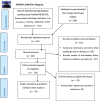Under-nutrition and associated factors among children infected with human immunodeficiency virus in sub-Saharan Africa: a systematic review and meta-analysis
- PMID: 34986885
- PMCID: PMC8728950
- DOI: 10.1186/s13690-021-00785-z
Under-nutrition and associated factors among children infected with human immunodeficiency virus in sub-Saharan Africa: a systematic review and meta-analysis
Abstract
Background: In the developing world, such as the sub-Saharan African region, HIV/AIDS has worsened the impact of under-nutrition in children. HIV infected children are highly vulnerable to under-nutrition. Therefore, the objective of this systematic review and meta-analysis was to estimate the pooled prevalence of under-nutrition, and the pooled effect sizes of associated factors among HIV-infected children in sub-Saharan Africa.
Methods: The primary studies for this review were retrieved from PubMed/ MEDLINE online, Science Direct, Hinari, web of science, CINHAL, EMBASE, WHO databases, Google, and Google Scholar databases. The articles selected for this meta-analysis were published between 2010 and 2020. The last search date was 18 October 2021. The data was extracted in Microsoft Excel format and exported to STATA Version 14.0. A random effect meta-analysis model was used. Heterogeneity was evaluated by the I2 test. The Egger weighted regression test was used to assess publication bias.
Results: We retrieved 847 records from these databases. Of which records, 813 were excluded due to different reasons and 34 studies were included in the final analysis. The pooled prevalence of stunting, underweight and wasting in HIV infected children was 46.7% (95% CI; 40.36-53.07, I2 = 98.7%, p < 0.01), 35.9% (95% CI; 30.79-41.02, I2 = 97.4% p < 0.01), and 23.0% (95% CI; 18.67-27.42, I2 = 96.9%, p < 0.01) respectively. The advanced WHO HIV/AIDS clinical staging (III&IV) [OR = 6.74 (95%: 1.747, 26.021), I2 = 94.7%] and household food insecurity were associated with stunting [OR = 5.92 (95% CI 3.9, 8.87), I2 = 55.7%]. Low family economic status [OR = 4.737 (95% CI: 2.605, 8.614), I2 = 31.2%] and increased feeding frequency [OR = 0.323 (95% CI: 0.172, 0.605), I2 = 69.8%] were significantly associated with under-weight. Anemia [OR = 2.860 (95% CI: 1.636, 5.000), I2 = 74.8%] and diarrhea in the previous month [OR = 4.117 (95% CI: 2.876, 5.894), I2 = 0.0%] were also associated with wasting among HIV infected children in sub-Saharan Africa.
Conclusions: The pooled prevalence of under-nutrition among HIV infected children was high. Nutritional assessment and interventions need great attention as a part of HIV care for HIV positive children. The implementation of policies and strategies established by national and international stakeholders in ART care centres should take a maximum emphasis on reducing under-nutrition among HIV infected children.
Keywords: Children; HIV positive children; Human immunodeficiency virus; Malnutrition; Sub-Saharan Africa; Under-nutrition.
© 2022. The Author(s).
Conflict of interest statement
All authors declare that they have no competing interests.
Figures







Similar articles
-
Prevalence and determinants of under-nutrition among children on ART in Ethiopia: A systematic review and meta-analysis.PLoS One. 2024 Jun 20;19(6):e0303292. doi: 10.1371/journal.pone.0303292. eCollection 2024. PLoS One. 2024. PMID: 38900809 Free PMC article.
-
Prevalence of undernutrition and associated factors among adults taking antiretroviral therapy in sub-Saharan Africa: A systematic review and meta-analysis.PLoS One. 2023 Mar 24;18(3):e0283502. doi: 10.1371/journal.pone.0283502. eCollection 2023. PLoS One. 2023. PMID: 36961844 Free PMC article.
-
Magnitude of underweight, wasting and stunting among HIV positive children in East Africa: A systematic review and meta-analysis.PLoS One. 2020 Sep 17;15(9):e0238403. doi: 10.1371/journal.pone.0238403. eCollection 2020. PLoS One. 2020. PMID: 32941443 Free PMC article.
-
Treatment failure among Sub-Sahara African children living with HIV: a systematic review and meta-analysis.Ital J Pediatr. 2024 Oct 1;50(1):202. doi: 10.1186/s13052-024-01706-w. Ital J Pediatr. 2024. PMID: 39354602 Free PMC article.
-
Prevalence of vertical HIV infection and its risk factors among HIV exposed infants in East Africa: a systematic review and meta-analysis.Trop Med Health. 2020 Oct 20;48:85. doi: 10.1186/s41182-020-00273-0. eCollection 2020. Trop Med Health. 2020. PMID: 33088209 Free PMC article. Review.
Cited by
-
Patterns of linear growth among children and adolescents living with HIV on antiretroviral therapy in Zimbabwe and Zambia.BMC Infect Dis. 2025 Feb 25;25(1):269. doi: 10.1186/s12879-025-10669-0. BMC Infect Dis. 2025. PMID: 40000995 Free PMC article.
-
The effects of height-for-age and HIV on cognitive development of school-aged children in Nairobi, Kenya: a structural equation modelling analysis.Front Public Health. 2023 Jun 21;11:1171851. doi: 10.3389/fpubh.2023.1171851. eCollection 2023. Front Public Health. 2023. PMID: 37415707 Free PMC article.
-
Prevalence and determinants of under-nutrition among children on ART in Ethiopia: A systematic review and meta-analysis.PLoS One. 2024 Jun 20;19(6):e0303292. doi: 10.1371/journal.pone.0303292. eCollection 2024. PLoS One. 2024. PMID: 38900809 Free PMC article.
-
The Spectrum of Pathogens Associated with Infections in African Children with Severe Acute Malnutrition: A Scoping Review.Trop Med Infect Dis. 2024 Oct 6;9(10):230. doi: 10.3390/tropicalmed9100230. Trop Med Infect Dis. 2024. PMID: 39453257 Free PMC article.
-
Prevalence of undernutrition and associated factors among adults taking antiretroviral therapy in sub-Saharan Africa: A systematic review and meta-analysis.PLoS One. 2023 Mar 24;18(3):e0283502. doi: 10.1371/journal.pone.0283502. eCollection 2023. PLoS One. 2023. PMID: 36961844 Free PMC article.
References
-
- Gedle D, Gelaw B, Muluye D, Mesele M. Prevalence of malnutrition and its associated factors among adult people living with HIV/AIDS receiving anti-retroviral therapy at Butajira hospital, southern Ethiopia. BMC Nutri. 2015;1(1):1–11. doi: 10.1186/2055-0928-1-5. - DOI
-
- UNICEF.: UNICEF data: Monitoring the situation of children and women, Accessed 7 july 2020. 2020.
-
- Organization WH. UNICEF/WHO/the World Bank Group joint child malnutrition estimates: levels and trends in child malnutrition: key findings of the. 2020th ed; 2020.
-
- UNCEF: Children, food and nutrition growing well in a changing world. In.; 2019.
-
- Friedman JF, Kwena AM, Mirel LB, Kariuki SK, Terlouw DJ, Phillips-Howard PA, Hawley WA, Nahlen BL, Shi YP, Ter Kuile FO. Malaria and nutritional status among pre-school children: results from cross-sectional surveys in western Kenya. Am J Trop Med Hyg. 2005;73(4):698–704. doi: 10.4269/ajtmh.2005.73.698. - DOI - PubMed
Publication types
LinkOut - more resources
Full Text Sources

